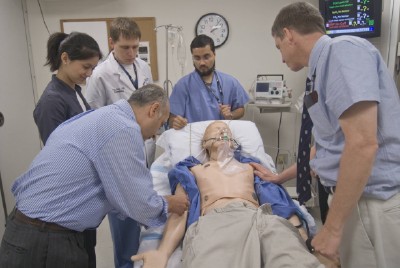STRATUS Expansion Brings New Educational Opportunities

Radiologists respond to an emergency situation simulation at STRATUS
What began in 2004 as a 1,500-square foot facility within the Department of Emergency Medicine has expanded to an interdisciplinary simulation center open to departments across the hospital for training and research. When the final phase of construction is complete, the STRATUS Center for Medical Simulation will encompass 11,000 square feet of space spread over two stories in the Neville House.
Along with the physical expansion comes additional simulation and supporting equipment and opportunities for every specialty to sharpen skills and train for a multitude of medical and surgical scenarios.
Medical Director Chuck Pozner, MD, likens the common operational model of STRATUS to a recording studio. “We provide the equipment and technical support, and departments and other groups provide their own content experts and students,” he said, adding that the hospital and BWPO now pay for departments to host courses there.
But it’s not simply the equipment that makes STRATUS an internationally known center; it’s the educational curricula that drive the training and skill-building. “You really need an infrastructure to support learning,” Pozner said.
The Department of Surgery, for example, has made STRATUS a regular part of the curriculum for residents. “We’re starting with interns this summer, but we will involve all residents, including our chief residents, beginning this fall,” said Doug Smink, MD, MPH, associate medical director of STRATUS and associate program director for the Surgical Residency Program.
Surgical interns practice basic skills, including suturing, laparoscopy and knot-tying, every other week. “They love it, not surprisingly,” Smink said. “And it’s extremely important for patient safety that our interns and residents have hands-on practice in addition to observing others performing procedures.”
In September, when Surgery begins to rotate all residents through STRATUS, Smink aims for a group to attend a two-hour session every week. “Their fellow residents will cover for them, so this is a time when their pagers are signed out to others and they can focus on learning without distraction,” he said.
A learning-management system and software in some of the simulation devices enable faculty and department leaders to track learner performance during training. Some of the simulators record faulty maneuvers, allowing staff to offer remediation and curriculum modification. “This recording software allows you to see what you did right or what you did wrong,” Pozner said.

Jennifer Irani and Rose Kakoza |
All trainees can sign in electronically when using laparoscopy and endoscopy simulators so that they can track their progress and hone in on specific areas for improvement. These simulators enable participants to perform a variety of procedures, including gall bladder removal and other surgical and gynecological operations. Haptic technology gives users a realistic sense of touch so that they feel pressure, resistance and other sensations when performing procedures. Basic training in hand-eye coordination, instrument handling and knot-tying using laparoscopic and arthroscopic trainers allows trainees to arrive in the Operating Room with a higher degree of competence, leading to more efficient surgical and endoscopic case management.
“This front-loaded training strategy allows interns and residents to achieve a higher point on the learning curve before they actually handle a real surgical case,” Smink said. “Simulated practice in STRATUS beforehand could enable trainees to do their initial cases safer and more efficiently, which can help with the scheduling of cases.”
STRATUS staff and faculty are seeking feedback on simulation’s effectiveness as a learning tool. The center recently received funding to sponsor a two-year fellowship in collaboration with the Harvard Graduate School of Education. “We will work with educators to help collect the data that we expect will support simulation as the correct model for clinical training and patient safety for all disciplines,” Pozner said.
To foster a multidisciplinary approach, STRATUS has convened a task force of assistant medical directors from Anesthesiology, Internal Medicine, OB/GYN, Emergency Medicine and Surgery who assist in the oversight of the center and curriculum development.
Interdisciplinary teams also are welcome. “At the hospital, you almost never have just one person from one department caring for a patient without interacting with others,” Smink said.
The technical team at STRATUS is adept at helping departments come up with strategies to simulate specific events or situations. “Whatever your idea is, we can try and find a way to bring it to life in the simulator,” Smink said. “We want everyone to use STRATUS as much as possible.”
Each piece of equipment, such as a new mannequin for anesthesiologists, was chosen carefully to meet the training needs of staff and create as realistic an experience as possible. The anesthesiology simulator is part of a new Operating Room identical to actual ORs on L1. There even is a scrub sink outside.
To help fund the equipment, STRATUS does international consulting work and offers training programs to many groups, including police, firefighters and emergency medical technicians. Other groups, such as Phillips Medical, use the center to test how their medical devices work in a clinical environment. “That, in turn, helps them design and improve their medical devices,” Pozner said.
STRATUS Board of Overseers
Andy Whittemore, MD, chief medical officer
Kate Walsh, chief operating officer
Elizabeth Glaser, vice president of Clinical Services,
Ron Walls, MD, chair of Emergency Medicine
Michael Zinner, MD, chair of Surgery
STRATUS Assistant Medical Directors
Anesthesiology: Sarah Wiser, MD
Emergency Medicine: Kathleen Wittels, MD
Internal Medicine: Paul Dellaripa, MD
OB/GYN: Jon Einarrson, MD
Surgery: Douglas Smink, MD